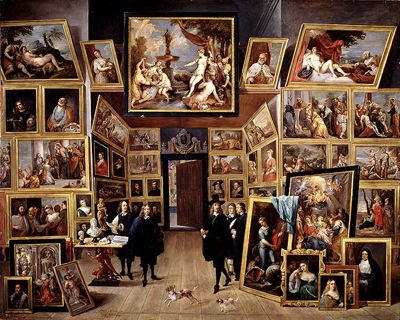Considering the nature of capital in the production of objects is a theme that is inherent within artist practice, whether directly or indirectly. This concept relates to everything from the time and materials available to produce work (dictated by sources of income), through to considering the consumer market for these artistic products.
The art market as an ‘object based economy’ has been discussed by Nicolas Bourriaud (in week 84) as a way of solidifying the world through inventing “modes of representation… for a reality that is becoming more abstract each day”. However, other artists are reflecting this “landscape of the insubstantial” through more conceptually based practices, such as Neil Cummings and Marysia Lewandowska’s 2001 project, ‘Capital’.
Capital
Capital was the inaugural project of the Contemporary Interventions programme, which was launched at Tate Modern in 2001. The programme was established to commission annual artistic projects in order to “enable artists and others to investigate and comment on the core practice of the museum”. As Lars Nittve, the director of the Tate Modern (1998-2001), described in his foreword to the exhibition catalogue: “With their project ‘Capital’, the artists [Neil Cummings and Marysia Lewandowska] have cut through and laid bare layer upon layer of micro- and macro- systems of structure, meaning and value in the museum and… its place in society’s systems of value, production and exchange”. (Capital, p7)
In particular, the application of Marxist and anthropological theoretical frameworks to artistic practice enabled Cummings and Lewandowska to produce “a series of encounters… between two iconic institutions and the economies they animate; the Tate and the Bank of England… triggered by the issue of a gift [in the form of] a beautiful limited edition artwork” (Neil Cummings and Marysia Lewandowska, ‘Enthusiasts, and the Enthusiasts Archive’). The project therefore, became the basis for a series of seminars, essays and interventions, which included an element where “arbitrarily chosen visitors [were] given a limited-edition print, issued by the artists, through a gallery official… Capital, the gift, [became] thus a gesture as much as a thing” (Capital, p13).
Gift Theory
This exploration of notions of value was predicated on the shared geographical space of the Tate and the Bank of England, as well as the utilisation of the gift in the formation of both organisations. As Frances Morris states in his essay ‘Gift, Economy, Trust’ in the exhibition catalogue for Capital: “Both Tate and the Bank of England were established by the act of giving. In 1694, the Bank was initiated by a loan to the government raised by public subscription… [while] Tate was founded by a gift [of money, paintings and sculpture] from the sugar magnate Sir Henry Tate in 1897” (Capital, p13).
The essay ‘I.O.U. Nothing’ by Jeremy Valentine further explores the notion of the gift through the work of the sociologist Marcel Mauss and the structural linguist and semiotician Emile Benveniste. According to Beneviste, “the common Indo-European roots of giving are indistinguishable from taking, by dint of ‘a curious semantic ambivalence’… Consequently, giving is indistinguishable from the obligation to return, and thus debt.” This argument is continued by philosophers such as Derrida in his 1994 book ‘Given Time’. Here, he considers the “impossibility of the gift” due to the intention and expectation of the giver: ‘A gift requires that there be no “reciprocity, return, exchange, countergift, or debt. If the other gives me back or owes me or has to give me back what I give him or her, there will not have been a gift, whether this restitution is immediate or whether it is programmed by a complex calculation of a long-term deferral or differance”.’ (http://www.leithart.com/archives/002003.php)
Symbolic economies
Derrida’s explorations of the gift were a reexamination of earlier theories of the time of exchange by Marcel Mauss. In his 1923 book ‘The Gift: Forms and Functions of Exchange in Archaic Societies’, Mauss investigates the notion of the potlatch. As Jeremy Valentine describes, potlatch is “a communal festival in which the community is affirmed by the consumption of the resources on which it relies, and which in their production organises the social relations of the community itself which potlatch destroys in order for such relations to be rebuilt, thus giving purpose to the labour of production itself.” (Capital, p50)
Although Valentine states that potlatch “constitutes a form of expenditure without return… (a pure gift)”, it also suggests a type of “symbolic economy” through which the production of goods is linked to the communities engaged in the exchange. (Capital, p50) These reciprocal networks of values and economies are the basis for the Capital project. As Cummings and Lewandowska summarise, “Objects – while acting as tools, products, works of art or commodities – are essentially vehicles for relationships between people” (Capital, p31)
Further reading:
Artist Jean McEwan uses ideas of gift and reciprocity in her practice in order to produce photographic and participatory work. You can find out more about her project at: https://www.a-n.co.uk/blogs/reciprocity
Also, Dave Beech’s ‘Art and Value’, expected publish date February 2015 http://www.brill.com/products/book/art-and-value
http://www.publicseminar.org/2014/04/is-this-still-capitalism/#.VGn2ufmsU-5
http://cdn.chtodelat.org/wp-content/uploads/2009/10/martin_autonomy.pdf


